The Interferon-Inducible Protein Tetherin Inhibits Hepatitis B Virus Virion Secretion
- PMID: 26109732
- PMCID: PMC4542364
- DOI: 10.1128/JVI.00933-15
The Interferon-Inducible Protein Tetherin Inhibits Hepatitis B Virus Virion Secretion
Abstract
Interferon alpha (IFN-α) is an approved medication for chronic hepatitis B therapy. Besides acting as an immunomodulator, IFN-α elicits a pleiotropic antiviral state in hepatitis B virus (HBV)-infected hepatocytes, but whether or not IFN-α impedes the late steps of the HBV life cycle, such as HBV secretion, remains elusive. Here we report that IFN-α treatment of HepAD38 cells with established HBV replication selectively reduced HBV virion release without altering intracellular viral replication or the secretion of HBV subviral particles and nonenveloped capsids. In search of the interferon-stimulated gene(s) that is responsible for the reduction of HBV virion release, we found that tetherin, a broad-spectrum antiviral transmembrane protein that inhibits the egress of a variety of enveloped viruses, was highly induced by IFN-α in HepAD38 cells and in primary human hepatocytes. We further demonstrated that the expression of full-length tetherin, but not the C-terminal glycosylphosphatidylinositol (GPI) anchor-truncated form, inhibited HBV virion egress from HepAD38 cells. In addition, GPI anchor-truncated tetherin exhibited a dominant-negative effect and was incorporated into the liberated virions. We also found colocalization of tetherin and HBV L protein at the intracellular multivesicular body, where the budding of HBV virions takes place. In line with this, electron microscopy demonstrated that HBV virions were tethered in the lumen of the cisterna membrane under tetherin expression. Finally, knockdown of tetherin or overexpression of dominant negative tetherin attenuated the IFN-α-mediated reduction of HBV virion release. Taken together, our study suggests that IFN-α inhibits HBV virion egress from hepatocytes through the induction of tetherin.
Importance: Tetherin is a host restriction factor that blocks the egress of a variety of enveloped viruses through tethering the budding virions on the cell surface with its membrane anchor domains. Here we report that interferon directly and selectively inhibits the secretion of HBV virions, but not subviral particles or nonenveloped capsids, through the induction of tetherin in hepatocyte-derived cells. The antiviral function of tetherin requires the carboxyl-terminal GPI anchor, while the GPI anchor deletion mutant exhibits dominant negative activity and attaches to liberated HBV virions. Consistent with the fact that HBV is an intracellular budding virus, microscopy analyses demonstrated that the tethering of HBV virions occurs in the intracellular cisterna and that tetherin colocalizes with HBV virions on the multivesicular body, which is the HBV virion budding site. Our study not only expands the antiviral spectrum of tetherin but also sheds light on the mechanisms of interferon-elicited anti-HBV responses.
Copyright © 2015, American Society for Microbiology. All Rights Reserved.
Figures
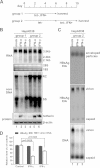

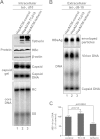
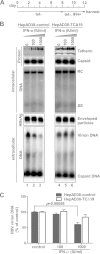
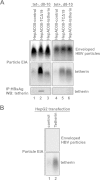

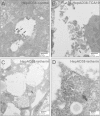

Similar articles
-
Early Vertebrate Evolution of the Host Restriction Factor Tetherin.J Virol. 2015 Dec;89(23):12154-65. doi: 10.1128/JVI.02149-15. Epub 2015 Sep 23. J Virol. 2015. PMID: 26401043 Free PMC article.
-
Identification of BST-2/tetherin-induced hepatitis B virus restriction and hepatocyte-specific BST-2 inactivation.Sci Rep. 2015 Jun 29;5:11736. doi: 10.1038/srep11736. Sci Rep. 2015. PMID: 26119070 Free PMC article.
-
Molecular dissection of HBV evasion from restriction factor tetherin: A new perspective for antiviral cell therapy.Oncotarget. 2015 Sep 8;6(26):21840-52. doi: 10.18632/oncotarget.4808. Oncotarget. 2015. PMID: 26334101 Free PMC article.
-
[Inhibition of HBV Release by BST-2].Bing Du Xue Bao. 2016 Mar;32(2):215-21. Bing Du Xue Bao. 2016. PMID: 27396167 Review. Chinese.
-
Emerging role of the host restriction factor tetherin in viral immune sensing.J Mol Biol. 2013 Dec 13;425(24):4956-64. doi: 10.1016/j.jmb.2013.09.029. Epub 2013 Sep 26. J Mol Biol. 2013. PMID: 24075872 Review.
Cited by
-
Knockdown of Autophagy Inhibits Infectious Hepatitis C Virus Release by the Exosomal Pathway.J Virol. 2015 Nov 18;90(3):1387-96. doi: 10.1128/JVI.02383-15. Print 2016 Feb 1. J Virol. 2015. PMID: 26581990 Free PMC article.
-
Control of Hepatitis B Virus by Cytokines.Viruses. 2017 Jan 20;9(1):18. doi: 10.3390/v9010018. Viruses. 2017. PMID: 28117695 Free PMC article. Review.
-
Mutations accumulated in the Spike of SARS-CoV-2 Omicron allow for more efficient counteraction of the restriction factor BST2/Tetherin.PLoS Pathog. 2024 Jan 8;20(1):e1011912. doi: 10.1371/journal.ppat.1011912. eCollection 2024 Jan. PLoS Pathog. 2024. PMID: 38190411 Free PMC article.
-
Host Cell Rab GTPases in Hepatitis B Virus Infection.Front Cell Dev Biol. 2018 Nov 19;6:154. doi: 10.3389/fcell.2018.00154. eCollection 2018. Front Cell Dev Biol. 2018. PMID: 30510928 Free PMC article. Review.
-
Hepatitis B Virus Subverts the Autophagy Elongation Complex Atg5-12/16L1 and Does Not Require Atg8/LC3 Lipidation for Viral Maturation.J Virol. 2018 Mar 14;92(7):e01513-17. doi: 10.1128/JVI.01513-17. Print 2018 Apr 1. J Virol. 2018. PMID: 29367244 Free PMC article.
References
Publication types
MeSH terms
Substances
Grants and funding
LinkOut - more resources
Full Text Sources
Other Literature Sources

